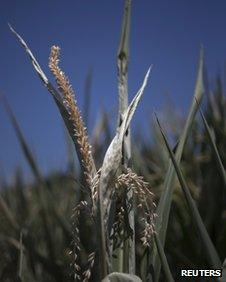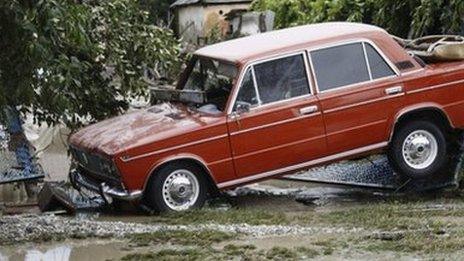Rain or shine, food under pressure
- Published

A corn plant, damaged due to lack of water, in a farmer's field in Centerville, Iowa
Crops are rotting in the fields because they've been beaten down by rain, and because farmers can't get machinery to them for harvest.
The prices may not have spiked yet, but if supply can't meet demand, there's not much doubt about the economic consequences.
Other pressures - of over-powerful customers or of over-capacity of processing - are this month hitting Scotland's dairy and pork farmers. All is not well with the nation's food chain.
But if you think ludicrous amounts of British rain is the main problem for food prices, think again. It's the heat, primarily across the corn belt of the USA, and more recently devastatingly heavy rain in Russia.
Such producer and exporter nations determine world prices. And the news out of Washington on Wednesday was not good for the price for the consumer.
The US government's estimate of the yield per acre this harvest season took a whopping cut of 20 bushels on previous estimates, down to 145. (A bushel of corn is around 25kg).
The total harvest is projected to be down 12% on June's reckoning.
With the price of corn up more than a third in the last month, wheat and soya - America's other dominant crops - are also sharply up in price, wheat by 22% since the start of the year, soya by 35%.
That follows the most searing summer heat for 24 years, with a lack of rain, though the spike in grain futures on Chicago markets fell back a bit when the weather forecast changed later on Wednesday to some rain, at least in some areas.
While rising grain prices don't automatically, proportionately transfer to food prices, they put pressure into the system, and feed into the price of feed for livestock as well as being key ingredients in a wide range of consumer foods.
Weather shocks
Also on Wednesday, from the UN's Food and Agriculture Organisation and from the Organisation for Economic Co-operation and Development came warnings that the next decade is going to see food prices rise by between 10 and 30%.
That's because of adverse weather shocks to the harvest, increasing demand - not only from more mouths to feed, but also from bio-fuel production - and higher input costs, notably oil.
We've already had two food price spikes in the past five years, both of them driving up general inflation and harming the chances of recovery. Across Europe, and including the UK, there's not much appetite for another way of cutting real income.
So, while several sectors within agriculture can look forward to higher prices, the sun isn't shining on the future cost of the grocery shopping basket.
- Published26 February 2012
- Published8 July 2012
